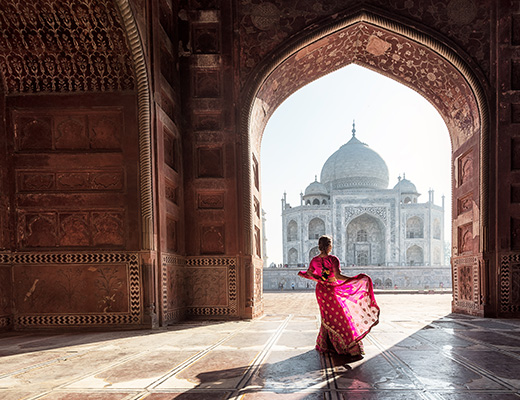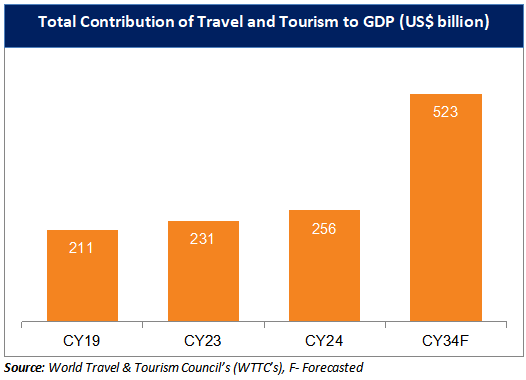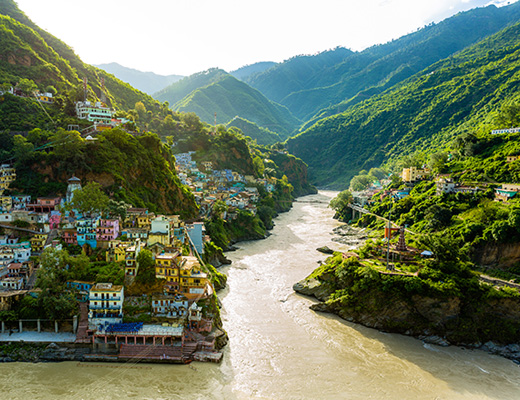Advantage India
Robust
Demand
*WTTC has revealed that international visitor spend in India reached a record Rs. 3.1 trillion in 2024.
*India’s expanding middle class and young, digitally engaged population are positioning the country as a key driver of global leisure travel growth, according to a report published by BCG in June 2025.
*India welcomed 20 million international visitors in 2024 reaffirming the country’s status as a leading global destination and underscoring the renewed international confidence in its tourism offering.
Attractive
Opportunities
*India is geographically diverse and offers a variety of cultures that come with its own experiences, making it one of the leading countries in terms of international tourism expenditure.
*There are ~23,828 DPIIT recognised startups in the Travel and Tourism Sector as on October 31, 2024.
*As of 2025, UDAN plans to connect 120 new destinations, including airports and helipads in Himachal Pradesh, Uttarakhand, and Northeast India, aiming to serve 40 million passengers over the next 10 years
Policy
Support
*India’s Union Budget FY26 has allocated Rs. 2,541.06 crore (US$ 291.07 million)to boost its tourism sector, focusing on improving infrastructure, skill development, and travel facilitation through measures like developing 50 top tourist destinations, offering MUDRA loans for homestays, enhancing connectivity, and introducing e-visa facilities.
*As of January 2025, the Ministry of Tourism sanctioned 52 projects under Swadesh Darshan 2.0 and 36 under CBDD, plus 40 large projects under SASCI.
*UDAN’s third round added 106 tourism routes, with 53 operational by January 31, 2025, and plans to link 120 destinations serving 40 million passengers in the next decade.
Diverse
Attractions
*India is geographically diverse and offers a variety of cultures that come with its own experiences, making it one of the leading countries in terms of international tourism expenditure.
*According to the Skift + FICCI report (March 2025), cultural and heritage tourism motivates 59% of international travelers to India. This segment has an estimated revenue potential of US$21.9 billion as of 2025.
*According to the Skift + FICCI report (March 2025), culinary tourism motivates 56% of travelers to India. The segment’s revenue potential is estimated at nearly Rs. 1,83,771 crore (US$ 21 billion), closely rivaling cultural tourism.
States with Largest Domestic Tourist Arrivals in 2021
- Tamil Nadu
- Uttar Pradesh
- Andhra Pradesh
- Karnataka
- Maharashtra
- Telangana

Posters
MORE
ANCIENT AND RICH
Approximately 8000 years old, India is the world's oldest surviving civilsation.
IBEF Campaigns
MORE
Aatmanirbhar Bharat Utsav 2024
Union Minister of External Affairs, Dr. S. Jaishankar and Union Commerce an...
Case Studies
MOREIBEF BLOG
MORERevival of India’s Forgotten Superfoods: Jackfruit, Amaranth and Moringa in Global Diets
For centuries, Indian kitchens have been home to an incredible diversity of...
Next-Gen GST: Powering India’s Investment and Demand Surge
India’s recent Goods and Services Tax (GST) overhaul is more than a s...
Transforming Spaces: The Growth and Opportunities in India’s Home Décor Industry
India’s home décor industry is evolving into one of the most d...














